|
|
Teddy

|
|
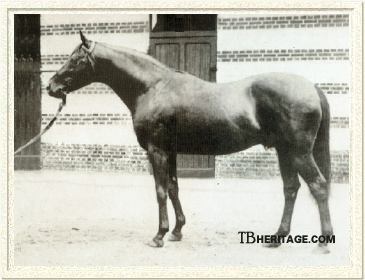 |
|
|
In the first decades of the Twentieth Century, racing and breeding took on a truly international flavor. When gambling was outlawed in New York in 1908, many of the leading owners in the U.S. shifted a large part of their racing and breeding stock to England and France to compete. French bloodlines became more familiar to American breeders, who appreciated the Gallic fascination with stamina; and the French didn't snub American strains that were considered "impure" in England. There was a healthy play back and forth between the continent and America, and few horses epitomized that more than Teddy and his sons.
Teddy was by a French-bred sire and out of an English-bred dam. Born in France, circumstances forced him to race in Spain, but he returned to stand at stud in his native land and later in America. As a stallion, Teddy's influence spread all over Europe, through his good sons like Ortello, Aethelstan, and Astérus; and important daughters like Anna Bolena and Rose of England. Three of his offspring - Sir Gallahad III, Bull Dog, and La Troienne - changed the face of American breeding altogether.
A product of the famed Haras de Jardy stud established by France's great breeder Edmond Blanc, Teddy was foaled in 1913. Blanc himself was born in 1856, into great wealth and good living. He became a racehorse owner at an early age, and purchased the filly Nubienne, who carried his colors when winning the Prix de Diane (French Oaks) in 1879, when he was just 23. A betting coup enabled Blanc to purchase Haras de Bel-Ebat in 1883, at La Celle, near Saint-Cloud, where he imported and installed the English stallions Scottish Chief, Energy and Retreat at stud. Energy was a particularly successful sire, getting Gouverneur and the siblings Reverend and Reuil (both out of the mare Reveuse). Retreat sired Blanc's fast filly Andree.
The breeder outgrew Bel-Ebat and purchased the larger, nearby Haras de Jardy, in 1889. In 1900, Blanc set a new world record price of 37,500 guineas when buying the Duke of Westminster's 4-year-old colt Flying Fox, who had won the English Triple Crown in 1899. At stud at Jardy, Flying Fox became a great success; the Leading Sire in France in 1904, 1905, and 1913. His first crop produced the great Ajax, who figures in the tale of Teddy. Blanc made one more landmark purchase, when buying Ksar as a yearling in 1919 from Evremond de Saint-Alary. Ksar became not only a great racehorse for Blanc, but based at Jardy, also a great sire. Ksar, like Teddy, ended his days in the U.S.
Blanc didn't get to enjoy Ksar's successes on the racetrack which included back-to-back Prix de l'Arc de Triomphe victories, dying in December of 1920, but his widow carried on the stud. Unfortunately, she didn't have the knowledge to continue it at the heights reached under her husband, but the Blanc influence on the Thoroughbred in France and the world proved enduring.
From the first crop by Flying Fox, Blanc bred the classy Ajax (b.c. 1901 out of Amie by Clamart), who brought early fame to his sire as a stallion, and it only took 5 starts to do it. At 2, Ajax's single appearance was in the Prix Saint-Firmin which he won. At 3, in quick succession, he scored in the Prix Noailles, Prix Lupin, Prix du Jockey Club, and Grand Prix de Paris, the latter being the premier event of the French sophomore season.
A training accident forced Ajax's retirement to stud at Haras de Jardy for the 1905 season. He was an immediate sensation but died at the young age of 14, in February of 1915. Ajax's best runners included the subject horse, Teddy; as well as Prix de Diane (French Oaks) winner Union, a daughter of Blanc's great filly Andree; the top class filly Azalee (winner of the Grosser Preis von Baden); Manchester Cup winner Marajax; and the good juveniles Mehari, Marka, El Tango and Good Luck. Ajax also had several important broodmare daughters which produced Flambette, Havresac II, Massine, and La Correge.
Ajax's stud career was foreshortened not only by his early death, but by World War I, which curtailed most of racing in France from 1914 through 1919. There was a significant amount of traffic across the Atlantic at this time moving horses to the U.S., but many also shipped to Spain to race. One of these was an Ajax colt out of the Blanc mare Rondeau, named Teddy.
In the same way he had acquired Flying Fox, from the dispersal of a major breeder, Blanc ventured to England for the 1906 dispersal of the bloodstock of the late Sir James Miller. The prize of the sale was English Triple Crown winner Rock Sand, who had stood the 1906 breeding season at Miller's Hamilton Stud. Rock Sand brought $125,000 from Maj. August Belmont, and was sent to Belmont's Nursery Stud in Kentucky, where he went on to an important stud career, before returning to France late in life.
Blanc's purchases at the Miller Dispersal included Rock Sand's 2-year-old half-sister Roquette (by Chaleureux), and the broodmare Rondeau (in foal to Rock Sand). Bred by Sir John Robison at his Worksop Manor Stud, Rondeau was from the first crop by the quality handicapper Bay Ronald. Bay Ronald's career as a stallion was still in front of him, since Dark Ronald was a yearling in 1906, and the great Bayardo just a foal. The appeal to Blanc at that time might have been due to Bay Ronald's son Macdonald, who was from the 1901 crop. Macdonald was foaled in France, and had already raced there with great success; so much so, that Bay Ronald was exported to stand in France for the 1906 season.
|

His dam, Rondeau
| |
Outside of the promise Macdonald had shown, in 1906, Rondeau's pedigree was far from fashionable, but she had worked her way up from selling races as a 2-year-old to a very useful stakes winner. Miller had picked her up at one of these post-race selling auctions (England's version of claiming races) at 2, and in his colors, she won the Plantation Stakes, Hardwicke 2YO Stakes and Prince of Wales's Nursery Handicap; and at 3, the Lowther, Dullingham and Champion Breeders' Biennial Foal stakes. At 4, she won another running of the Dullingham and placed second in the Cesarewitch.
|
With her race record and her sire's star on the rise, Rondeau appeared to be a mare of promise, but she was a problematic producer, and was looking like a liability right up to the moment that she dropped Teddy in 1913. The foal she was carrying at the time of her purchase (by Rock Sand) died while still at her side. She then had a useless Flying Fox; and three more dead foals. It must have been a relief when she finally had the surviving colt Karimah (1912 by Ajax), although he, too, was unraced.
Bred back to Ajax, Rondeau had a second successful foaling in 1913, delivering the bay colt later named Teddy. He was her only good racehorse. In 1914, she had a full sibling, a filly named Eugenique, who carried on Rondeau's female line by a thread until it came to America with her great-granddaughter Bastogne II. In the U.S. the family has done well, and the great American champion Point Given (foaled in 1998) claims Bastogne II as his sixth dam, and Eugenique as his ninth dam.
Teddy on the Turf
Teddy was just a yearling when World War I broke out in 1914, and Blanc sold him for 5,400 francs to the controversial Capt. Jefferson Davis Cohn. Something of an unsavory society character, Cohn's occupation has been variously described as "British sportsman-adventurer" and "ubiquitous lounge lizard". He was also a an entrepreneur, and partner on the Wagon-Lits Sleeper Car railroad fortune. If his name rings familiar, Cohn was named for his godfather, Jefferson Davis, president of the Confederate States of America during the American Civil War. In the purchase of Teddy, he became a major force in French breeding and racing with such notables as Sir Gallahad, Bull Dog, Admiral Drake, Vatout, Guerriere, Queen Iseult and Le Traquet. Cohn leased Haras du Bois Roussel in France for about 20 years and sold the entire stud to Leon Volterra in 1934.
Cohn took his newly purchased Teddy to San Sebastian, the premier course in Spain. Unraced at 2, Teddy was unleashed at 3, winning 5 of 7 starts, and dominating his division while racing in both Spain and France. He started with the the Gran Premio San Sebastian (2400 meters) in his debut, also won the Premio Villamejor (Spanish St. Leger, also at San Sebastian but over 2800 meters), and was third in the Copa d'Oro del Re (2400 meters; Gold Cup at San Sebastian).
In France, Teddy won the Prix Darbonnay (1700 meters), Prix Darney, and Prix des Trois Ans (the Prix du Jockey Club substitute race at 2400 meters), all in a matter of eight days. He was later third in the Prix d'Elevage to Antivari and San-le-Sou. At 4, he returned to France for one final start and bested La Farina by a neck in the Prix des Sablonieres (2400 meters). Teddy retired with 6 wins in 8 starts, and a reputation as one of the best French horses of the war-torn period.
Teddy in the Stud
An unmarked bay standing a little more that 16 hands high, Teddy was not the typical French thoroughbred of the time, an era and country in love with stamina. Although proving he was up to the classic distances, he was a more full-bodied type like his duplicated ancestor Bend Or, but well balanced, with powerful shoulders and large hindquarters. Teddy's forearm was long and cannon short, although he was a little light of bone below the knee. He appeared just slightly over at the knee, a characteristic he shared with his dam's sire Bay Ronald. Teddy's hind leg was a model, with a good angle to the hock. As a sire, he did not stamp his get in any particular size, model or aptitude; but he got a good big, handsome individual, usually with that wonderful long forearm, short cannon and big hindquarter.
Teddy covered a few of Cohn's mares as a five-year-old year, including the Spearmint daughter Plucky Liege, which Cohn had acquired from his one-time employer Lord Michelham. The filly resulting from that union was MARGUERITE DE VALOIS (1919), who was stakes-placed. Imported to the U.S., she is the tail-female ancestress - through the good race mare Hostility - of Fappiano, Ogygian and Quiet American. Another from that first crop was the stakes-winning filly LADY ELINOR, later dam of Vatellor. From his third crop, in 1920,Plucky Liege produced the brilliant colt SIR GALLAHAD, who helped jump his sire to the top of the French stallion list in 1923. The same crop produced the filly ANNA BOLENA who added to the glamour with a win in the Poule d'Essai des Pouliches (French 1,000 Guineas).
Teddy stood at various locations early in his career. When finally let out of training, he stood the 1920 season at Haras de Fitz-James, and later at Haras du Bois Roussel (at Alencon, Orne), which J.D. Cohn leased as a headquarters for his breeding stock for many years.
The Leading Sire in France in 1923, and in the top 3 in 1925, 1926, 1928, 1929, and 1932; Teddy ultimately sired 65 stakes winners. His first top class runner was SIR GALLAHAD (Poule d'Essai des Poulains - French 2,000 Guineas), foaled in 1920. The 1922 crop yielded up ASTERUS (Poule d'Essai des Poulains, Champion Stakes), and the good colts AETHELSTAN and PTOLEMY. MEDEA came in the 1924 crop; LA MOQUEUSE, BRUMEUX, and LEONIDAS in 1925; ORTELLO, ELSA DE BRABANT and a non-winning filly sister to Leonidas named LA TROIENNE in 1926; ROSE OF ENGLAND (English Oaks), BULL DOG and POTIPHAR in 1927; SALPIGLOSSIS, TRUCULENT AND QUATRE BRAS in 1928; AVENTIN, BISHOP'S ROCK, SHRED, and INCESSU PARTUIT in 1929, BETTY (Coronation Stakes), and ASSIGNATION (fourth dam of Secretariat) in 1930; BOXEUSE and MERCIA, in 1931 and PHILLIPPA OF HAINAULT and TARA in his last French crop.
Teddy's son SIR GALLAHAD was sold to stand at Claiborne Stud in Kentucky, and in 1930 became America's Leading Sire with just 2 crops running, the first including the great Gallant Fox. This led to a pair of significant importations in 1931, the first being Sir Gallahad's full brother BULL DOG, and the second, none other than Teddy himself. A driving factor in this turn of events may have been Cohn's business reversals in 1929 and an ugly divorce in 1931. A few years later, he sold Haras du Bois Roussel to Leon Volterra lock stock and barrel, including the stallions Admiral Drake and Vatout, and the aging blue hen Plucky Liege (dam of Admiral Drake, Sir Gallahad, Bull Dog, Quatre Bras, Marguerite de Valois, Elsa de Brabant, etc.), who was carrying Derby winner Bois Roussel at the time.
Teddy was purchased by Americans F. Wallis Armstrong and Kenneth Gilpin and he stood at Gilpin's Kentmere Farm, near Boyce, Virginia. He was joined there by another great French horse with a tie to Edmond Blanc, the mighty Ksar, who arrived in 1935 at the age of 17, and died in 1937. Teddy passed in 1936 from a twisted gut aged 24 years, and was buried near the house at Kentmere. His gravestone has since been lost, but the memory of the great stallion from France remains a legacy of the place.
|
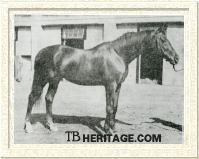
Ortello
| |
Teddy's best racing son was ORTELLO (ch.c. 1926 out of Hollebeck by Gorgos). A towering chestnut horse at 17 hands, Ortello was bred by Haras Ticino in Italy and purchased by Giuseppe de Montel. At 2, Ortello ran 5 times, winnng the Premio Cornredo, Premio Luino, Premio Volta and Premio Chisura, the latter against older horses. His only black mark was when second by a head to Aruntius in the Gran Criterium. At 3, Ortello won 8 races including the Derby Reale, Gran Premio d'Italia (new course record), Gran Premio di Milano (beating the older Pinceau), and Premio del Fascio (Italian St. Leger, by 15 lengths) in Italy. At the end of the season, he faced the best of Europe, winning the Prix de l'Arc de Triomphe, beating Kantar and Oleander, although his last start of the year was a loss to the season's top juvenile in the Premio Chiusura by just a head.
|
At 4, Ortello won 4 of 5 starts, losing only a return engagement in the Prix de l'Arc de Triomphe on a heavy course which he disliked, finishing fourth. He retired with 16 wins in 19 starts and was the champion of his generation in Italy. Sent to stud at his owner's Haras de Gornate for the 1931 season, Ortello was one of the most important native sires of the period. The Leading Sire in Italy 6 times (1937, 1939, 1940, 1941, 1942, 1944), his offspring dominated that country's classics, including Italian Derby winners Ugolina da Siena (from his first crop; later sire of the great show jumpers Merano and Posillipo), Vezzano and Torbido; Italian Oaks winner Nervesa; Gran Premio del Jockey Club winners Milazzo and Zuccarello, and other outstanding runners Fiume, Sirte, Macherio, Aristeo, Allgau, and Moroni. Nearly every one of his best sons became classic sires in Italy, and Sirte was a good steeplechase sire in the U.S. His daughters Nervesa, Aspertina and Signa still appear in top class pedigrees today.
Ortello was sold in October of 1946, at the age of 20, and was imported to stand at Glen Cove Stud, Vallejo, California. His time in the U.S. was short, and in April of 1947, the grand old horse suffered a heart attack and died, having serviced only 13 mares in his adopted country. He left no offspring of importance in the U.S.
|
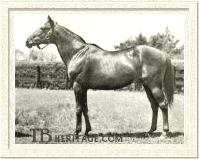
Sir Gallahad
| |
From Teddy's second crop came SIR GALLAHAD (bay colt 1920 out of Plucky Liege by Spearmint), one of his best runners and best sire sons. Bred in France by Jefferson Davis Cohn and the second foal out of his great broodmare mother, he was one of the best colts of his crop, but Sir Gallahad's exploits were overshadowed by Epinard, who dominated his crop and was sent to America for serious of special international events. Sir Gallahad scored in 12 races from 24 starts, but his career as a stallion was much more important. |
A winner of 3 races in 5 starts at 2, SIR GALLAHAD won the Prix Eclipse (1300 meters), Prix du Petit Couvert (1000 meters) and Prix de la Mediterranee (900 meters). At 3, he won 4 races, the Poule d'Essai de Poulains (French 2,000 Guineas, 1600 meters), Prix Daphnis (1800 meters), Prix Edgard de la Charme (2000 meters) and Prix Jacques le Marois (1600 meters); he also placed second in the Prix Royal Oak and third in the Prix du Jockey Club. At 4, he won the Lincolnshire Handicap (a mile or 1600 meters) in England, the Prix Boïard (2000 meters), Prix Daphins (1800 meters), and Prix Edgard de la Charme (2000 meters) and ended the season by defeating the great Epinard in a match over 6 and a half furlongs. Obviously a colt of high ability, Sir Gallahad proved himself to be a little below the true classic standard stamina-wise; he never won beyond 2,000 meters (a mile and a quarter).
Sir Gallahad stood his first season in France in 1925 before being purchased by an American syndicate headed by A.B. Hancock and William Woodward for $125,000. On the ship Minnetonka, he came across the Atlantic as so many Thoroughbreds had, and relocated to Claiborne Farm in Kentucky. His first American crop, foals of 1927, included Triple Crown winner Gallant Fox. He became the American Leading Sire in 1930, 1933, 1934, and 1940, and was that country's Leading Broodmare Sire 12 times as well. He got a lot of precocious colts and fillies, reflecting his own good speed, but more than a few of his get were up to the American classic standard and in general, his influence has leaned toward stamina. He was a big horse at 16.1 hands, had good feet and legs and a good temperament although he could be a little fiery at times.
Sir Gallahad's first (French-bred) crop included nothing of note, but his next one, bred in Kentucky, kicked off a tremendous stallion career. In all, he sired 567 foals, 64 of which won stakes. He was vigorous and fertile, siring his last crop when 28 years old, and dying the next year, in 1949. He was buried in a special site at Claiborne, next to Gallant Fox's dam Marguerite, although there is a stone marker for him in the Claiborne Stallion Cemetery.
Sir Gallahad's 1927 crop produced not only the great champion and Triple Crown winner Gallant Fox (sire of Omaha and Granville), it also featured the Alabama Stakes winner Escutcheon, and stakes winners Flying Gal, The Scout and Pansy Walker. Besides Gallant Fox, Sir Gallahad got 2 additional Kentucky Derby winners - Gallahadion and Hoop Jr.; the Preakness Stakes winner High Quest; and Travers Stakes winner Fenelon. His champions were the great racemare Vagrancy, Happy Gal (champion filly at 2), Foxborough (brother to Gallant Fox and champion at 2 in England), and Tintagel (champion colt at 2).
His other good ones included Roman (sire of champions Hasty Road, Romanita and Broodmare of the Year Pocahontas; and Leading Broodmare Sire 3 times), Fighting Fox (another brother to Gallant Fox, and sire of champions Fighting Step and Crafty Admiral), Insco (sire of champions Unerring and Inscoelda), Hadagal, Black Devil (Doncaster Cup), Count Gallahad, Sir Damion, Sir Andrew, Bold Irishman, and Amphitheatre.
Sir Gallahad was the Leading Broodmare Sire in the U.S. 12 times, being the dam's sire of champions and classic winners Gallorette, Challedon, Prince Simon, Jacola, Johnstown, Black Tarquin, Jet Pilot, and Boswell to name just a few.
Teddy's owner, J.D. Cohn, bred a second classic winner from the same crop as Sir Gallahad named ANNA BOLENA (b.f. 1920 out of Queen Elizabeth II by Wargrave). Winner of 3 races, including the Prix Chloe and Poule d'Essai des Pouliches (French 1,000 Guineas), both at a mile, Anna Bolena went on to produce an even better one in her daughter Mary Tudor (1930 by Pharos), who won the Poule d'Essai des Pouliches, as well as the Prix Vermeille, Prix d'Harcourt, Prix Chloe, and second in the Prix de Diane (French Oaks). Mary Tudor produced the Derby/Ascot Gold Cup winner Owen Tudor.
|
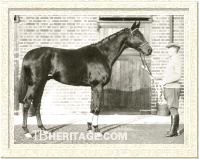
Astérus
| |
ASTERUS (b.c. 1923 out of Astrella by Verdun) was another French classic winner sired by Teddy. Bred by Baron Maurice de Rothschild, he raced for Marcel Boussac. At 2, Asterus won 3 of 4 starts and was the third highweight among his age that year. At 3, he only won 2 of 9 starts, one of those being the mile classic Poule d'Essai des Poulains (French 2,000 Guineas) and the other the Prix Greffulhe. At 4, he won the Champion Stakes and Royal Hunt Cup in England and retired back to Boussac's Haras de Fresnay-le-Buffard. |
As a stallion at Boussac's Haras de Fresnay-le-Buffard, he was 2nd 1933; became the Leading Sire in France in 1934 and the Leading Broodmare Sire 6 times from 1943, 1944, 1945, 1946, 1947 and 1948, nearly all on the strength of Boussac-breds. Astérus's best runners included Prix de Diane (French Oaks) winner Adargatis (dam of Ardan and Pardal), Deutches Derby winner Magnat, Premio Del Jockey Club (Italian Derby) winner Ostia, Prix du Cadran (French Gold Cup) Astrologer, as well as Assuerus, Astrophel, Asbestos, Kipling, Abjer, Ad Astra, Astronomie (a great broodmare) and Jock.
|
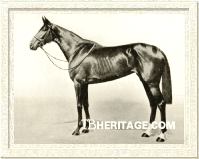
Rose of England
| |
Teddy also sired a classic winner in England when the aptly named ROSE OF ENGLAND (br. f. 1927 out of Perce-Neige by Neil Gow) won the Oaks. Bred by Lady James Douglas of Harwood Stud, the filly was offered as a yearling and purchased by Lord Glanely for 3,100 guineas. In 6 starts, her only win was the one that counted, and taking advantage of the inability of Lord Derby's filly Fair Isle (sister to Pharos and Fairway) to go the classic distance, Rose of England's superior stamina took her to victory in the mile and a half Oaks at Epsom. |
Rose of England did little else for her owner outside of a fourth in the Coronation Stakes, but proved a fine broodmare at Westerlands Stud. She had 10 foals, 8 winners, 4 stakes winners, including St. Leger winner Chulmleigh (by Singapore), Newmarket Oaks winner Faerie Queene (by Solario) and British Empire (by Colombo) who became an outstanding sire in Argentina. Rose of England died in 1947.
BRUMEUX (b.c. 1925 out of La Brume by Alcantara II) is considered one of the best racing sons of Teddy in a career that straddled that English Channel. Bred by the Duc Decazes in France, his dam, La Brume, was a full sister to the French runner and 1943 Leading Sire Pinceau. Brumeux was a top class stayer and won 6 of 22 starts including the Prix Edgard Gillois (2600 meters) and 2 other victories, plus a second in the Prix du Cadran in his native country; and 3 wins including the Newbury Autumn Cup (17 f.) and Jockey Club Cup (18 f.) in England.
Sent to stud in England, Brumeux sired the Coronation Cup winner Borealis, German Derby winner Herero, Newmarket St. Leger winner Cardington King, Grand National winner Early Mist, also Favreale, Stream of Light, and Pantheon. Brumeux's main influence comes through Borealis's great broodmare daughters Queen of Light and Highlight. Brumeux's son Pantheon became an important sire in Germany, his most important offspring being the champion German filly Schonbrunn, from which descends Sagace, Steinlen and Zagreb.
Teddy's daughter LA MOQUEUSE (b.f. 1925 out of Primrose Lane by Llangwm) was bred by Marcel Boussac at Haras de Fresnay-Le-Buffard. She started 16 times, winning 5 races including the Prix La Rochette at 2, and the prestigious Prix de la Foret, an all-aged sprint, and Prix du Rond-Point when a 3-year-old. She was also second in the Poule d'Eassai des Pouliches (French 1,000 Guineas), and Prix de Seine et Oise. As a broodmare for Boussac, she produced Prix Vermeille winner La Circe (by Ksar) and the unraced Pretty Lady (by Umidwar), dam of Boussac's champion 2-year-old Abdos.
|
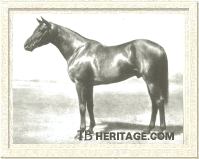
Shred
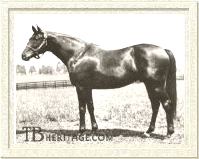
Bull Dog
| |
J.D. Cohn also bred and raced Teddy's colt POTIPHAR (b.c. 1927 out of Lovely Clovelly by Clarissimus). Potiphar won 5 of 14 starts, including the Prix Thomas Bryon at 2, and the Prix Daru and Prix Eugene Adam at 3. He left no significant record as a stallion.
A full brother to Sir Gallahad, J.D. Cohn's BULL DOG (b.c. 1927 out of Plucky Liege by Spearmint) was foaled after his older sibling had made his name and was already at stud in Kentucky. The younger brother wasn't quite as good on the track, although a true rival as a stallion.
At 2, Bull Dog ran 3 times but ended the season winless. Unplaced in his debut, he ran a solid second to a dominating Chateau Bouscaut in the Prix Robert Papin next out, then showed nothing in the Prix Morny, won again by champion Chateau Bouscaut. At 3, Bull Dog came home a winner for the first time in the Prix Daphnis at a mile. Next out he ran a disappointing fourth in the Poule d'Essai des Poulains (French 2,000 Guineas) won by Xandover, who he had beaten in the Daphnis. Unplaced in another pair of stakes, Bull Dog regained his form in the Prix La Fleche d'Or, also at a mile, against moderate opposition.
|
At the end of the 1930 season, Cohn sold BULL DOG to American Charles B. Schaffer who owned the famed Coldstream Stud in Kentucky. At that point in time, Sir Gallahad's first and second crop had dominated American racing, and he was headed toward his first sire championship. Bull Dog was found to be just as desirable as his brother, and proved successful in his own right, leading the Sire List in 1943 (when his son Occupy was the lead money-winning 2-year-old), while his son Bull Lea was champion sire 5 times. Bull Dog proved more of a speed influence than his brother, his forte being precocious juveniles like Occupy (co-champion at 2 with Platter), Occupation, Our Boots (co-champion at 2 with Whirlaway), John's Joy, Tiger and Coldstream. His best racing son was a divergent type, Bull Lea, who won the Blue Grass Stakes and Widener Handicap and became the foundation sire for Calumet Farm. Bull Dog also got the handicappers Bull Reigh, The Doge and Woof Woof.
BULL DOG'S racing daughters included Alabama Stakes winner Floradora, Santa Margarita Handicap winner Canina, and Kentucky Oaks winner Miss Dogwood. Again, like his brother Sir Gallahad, Bull Dog became an important broodmare sire, leading that Sire List 3 times in 1953, 1954 and 1956. His most important producing daughter was Gaga, dam of champions Tom Fool and Aunt Jinny. His daughters also produced Dark Star, Imbros, Rough'n Tumble, Decathlon, Prince Blessed, Star Pilot and Donut King.
|
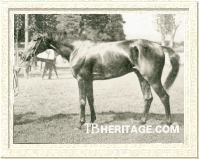
Ptolemy
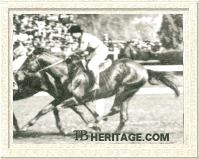
Aethelstan
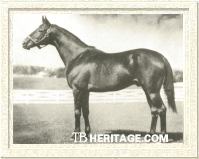
Quatre Bras
| |
Another Jefferson Davis Cohn product, PTOLEMY (br.c. 1922 out of Macedonia by Sea Sick) showed class at 2 and 3, winning the Prix Yacowlef and Grand Criterium as a juvenile and the Prix Eugene Adam the next year. He also placed second in the Poule d'Essai des Poulains (French 2,000 Guineas), third in the Prix de l'Arc de Triomphe, and fourth in the Prix du Jockey Club (French Derby). Not a particularly successful sire, Ptolemy's daughter Coralmy became the second dam of Leon Volterra's classy stayer Val Drake. Ptolemy also sired the Grand Steeple-Chase de Paris winner Symbole.
AETHELSTAN (b.c. 1922 out of Dedicace by Val Suzon) was also bred by Cohn and was one of several Teddy sons to establish himself as an important sire and sire of sires, as well as joining the club by shipping to America in his old age. Winner of the Prix Saint Firmin at 2 and Prix Daphnis at 3, he also counted the Prix Gontaut Biron among his 9 victories. He became a perennial leading sire in France and proved a great source of stamina, siring 2 winners of the Prix Royal Oak (French St. Leger) in Fantastic and Deiri, and Grand Prix de Paris winner Maurepas. Fantastic sired classic milers Tyrone and Free Man. Deiri's sons Deux Pour Cent, Bey and Majano all bred on. Deux Pour Cent's son Tantième became a very important sire whose offspring included Tanerko, Reliance, and Match. Aethelstan was brought to the U.S. in 1937 but sired nothing of importance here.
Other good ones got by Teddy while he stood in France include Gran Premio d'Italia winner SALPIGLOSSIS, Grand Prix de Deauville winner CELERINA, Prix Vermeille winner CRISA, Coronation Stakes winner BETTY, Prix Lupin winner SHRED, Prix Hocquart winner BISHOP'S ROCK, also QUATRE BRAS (brother to Sir Gallahad and Bull Dog), and LEONIDAS. The latter won the Lincolnshire Handicap in England, but is better remembered as the full brother to a mare who couldn't win at all, LA TROIENNE (b.f. 1926 out of Helene de Troie by Helicon), one of the greatest broodmares in American history.
|
Teddy's first American foals were born in 1933 and included SUN TEDDY (ch.c. 1933 out of Sunmelia by Sun Briar), who was third in the Hopeful Stakes at 2, and winner of the Arlington Handicap, Saranac Handicap, and second in the Travers Stakes at 3. Bred by Kenneth Gilpin, he was sold as a yearling to Calumet Farm for which he raced.
|
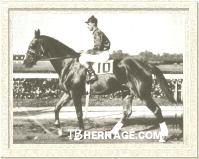
Sun Teddy
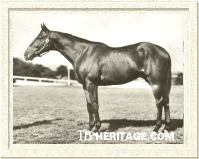
Case Ace
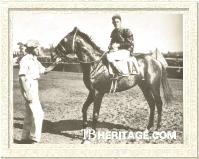
Teddy's Comet
| |
Sun Teddy retired to stud at Calumet Farm where he had a short but productive breeding career, dying after the breeding season of 1943. From just 6 crops he got 6 stakes winners, the best of which was the flashy Sun Again, who retired back to Calumet for an even better stud career. Sun Again sired the Calumet champion filly Wistful, as well as the tough handicappers Palestinian (sire of Promised Land) and Sunglow. Sunglow was the sire of Sword Dancer, who extended this male line even further when getting the great runner and very successful sire Damascus, and the champion filly Lady Pitt (in the pedigree of champion Heavenly Prize). Sun Teddy also sired the useful stakes winners Air Patrol and Sun Herod.
While Sun Teddy was bred by part-owner Kenneth Gilpin, CASE ACE (b.c. 1934 out of Sweetheart by Ultimus) was bred in New Jersey by Gilpin's partner on the Teddy project, F. Wallis Armstrong. Case Ace was sold as a yearling for $10,000 to Milky Way Stables and was one of the juvenile stars of 1936. He equaled the track record for 5 furlongs at Arlington, and followed up with a win in the rich Arlington Futurity. At 3 he won the Illinois Derby. Retired to stud in New Jersey, he became a prolific sire. His best was Pavot, champion at 2 and Belmont Stakes winner at 3, but he also sired Good Call, Lochinvar, Ace Card and most importantly, Raise You. Raise You was a stakes winner at 2 and dam of the brilliant Raise a Native, a horse who proved prepotent for all the raw speed and precociousness Case Ace added to the mix through Teddy and Ultimus.
Case Ace's year-older full brother TEDDY HASLAM (g. 1933 out of Sweetheart by Ultimus) didn't come into his own until he was 4, winning the King Edward Gold Cup and Ontario Jockey Club Handicap in Canada; and at 5 won the Bryan and O'Hara Memorial Handicap.
Teddy's 1935 crop included TEDDY'S COMET (br.c. out of Flying Comet by Peter Pan) was bred on a similar cross as Case Ace and Teddy Haslam, both out of Domino-line mares. He only raced at 2, winning the rich Arlington Futurity and 5 other races from 17 starts. At Valdina Farm in Texas, he was a good sire, getting Colonel O'F and Tidy Sum among his 12 stakes winners.
|
The 1936 crop brought KNICKERBOCKER (ch.c. 1936 out of Warrior Lass by Man O'War) out of a half-sister to Case Ace and Teddy Haslam. He won the Metropolitan Handicap at 3. At stud, he sired only 13 foals and 1 stakes winner.
Teddy's final crop was punctuated by the good filly TEDBRIAR (f. 1937 out of Sunmelia by Sun Briar), a full sister to Sun Teddy. She was second in the Selima Stakes at 2 and won the Newcastle Handicap at 3.
Teddy's sireline continues to this day through several different strips. Sir Gallahad's son Gallant Fox sired Omaha and Granville, both of which were disappointing, but Omaha's brother Flares sired the Canadian stallion Chop Chop, who got the Canadian Leading Sire Victoria Park, sire of Kennedy Road and others. Gallant Fox's own brother Fighting Fox continued the male line through his son Crafty Admiral, to Admiral's Voyage. Aethelstan's line continued through Deiri, Deux Pour Cent, and Tantième. Sun Teddy's line is the strongest of all, through grandson Damascus and his many good sire sons including Private Account, Bailjumper, Timeless Moment, and Time For a Change.
Teddy's daughters also exerted a lasting influence. The most important, of course, was La Troienne, who produced 5 stakes winners led by champions Bimelech and Black Helen. She's the tail-female ancestress of many champions and classic winners including Busher, Buckpasser, Straight Deal, Numbered Account, Easy Goer and Smarty Jones.
Teddy's other good broodmare daughters were Anna Bolena (dam of Mary Tudor), Rose of England (dam of British Empire, Chulmleigh), Royal Mistress (dam of Atout Maitre), Celerina (dam of Grand Prix de Paris winner Pensbury), Glorieuse (dam of Italian champion Gladiolo), Tara (sire of Norseman, Sans Tares), Lady Elinor (dam of Vatellor), Marguerite de Valois (dam of Hostility), Mercia (dam of Le Petit Prince), Persephone (dam of Amfortas), Queen Iseult (dam of Le Ksar and William of Valence), Assignation (ancestress of Alleged and Secretariat), Coeur A Coeur (a foundation mare for Marcel Boussac and granddam of Djebel), Boxeuse (granddam of Herbager) and Tedmelia.
Teddy saw his first dawn in France and ended his days in America. His influence on the breed likewise started in France and crossed the Atlantic many times, making Teddy one of the most important stallions of the twentieth century and a truely international star.
-- Anne Peters |
|
|
|

